Catholic Customs
 |
 |
 |
 |
 |
 |
 |
Holy Thursday Bread & Greens
The three greatest days of the Catholic year begin on that solemn day on which Our Lord instituted the Holy Sacrifice of the Mass: Holy Thursday, the first day of the Triduum.
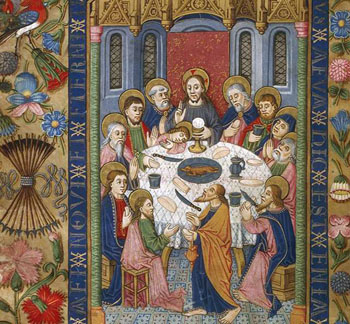 Many pious Catholics of the past honored these sacred days by not eating anything from the afternoon of Holy Thursday until Easter Sunday morning. Those who undertook this fast often drank holy water blessed on Holy Thursday as their only nourishment. (1)
Many pious Catholics of the past honored these sacred days by not eating anything from the afternoon of Holy Thursday until Easter Sunday morning. Those who undertook this fast often drank holy water blessed on Holy Thursday as their only nourishment. (1)
In the Middle Ages, there were three Masses celebrated on this day. The first Mass was the "Mass of Remission" during which the public penitents were solemnly received back into the Church. The second Mass, which is still said today, is the "Chrism Mass". During it the Bishop blesses the holy oils to be used in his Diocese in the coming year. The third Mass is the "Mass of the Lord's Supper" in commemoration of the institution of the Holy Eucharist and the priesthood.
The symbolism of the liturgy of these Masses inspired Catholic peoples to develop their own particular customs and devotions.
Bread Baking in honor of the Bread of Life
The day on which the Bread of Life fed His Apostles with His own Body and Blood could not but inspire Catholic housewives to choose this day to bake bread as a remembrance of their beloved Lord. In many countries, special rolls were eaten at the Holy Thursday breakfast. According to tradition, the rolls were always served with honey.
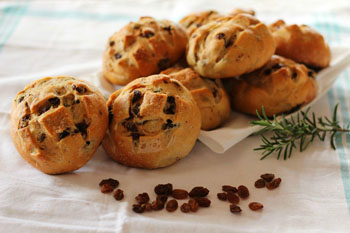
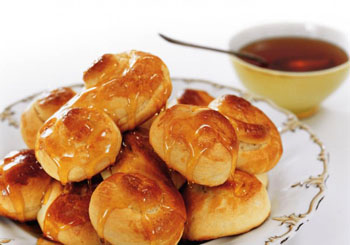 How fitting a combination of bread and honey, since the Holy Eucharist was prefigured by the Manna in the desert which Sacred Scriptures describes as having "the taste thereof like to flour with honey." (Ex 16:31)
How fitting a combination of bread and honey, since the Holy Eucharist was prefigured by the Manna in the desert which Sacred Scriptures describes as having "the taste thereof like to flour with honey." (Ex 16:31)
Every region had their unique recipes for Holy Thursday rolls. In Florence, every good housewife baked Panini di Ramerino (rosemary buns), marking each bun with a cross. In Germany, the rolls were filled with honey and called Judasohren (Judas' ears) or Judasbrötchen, while in Czechoslovakia the Jidášky (sweet breads shaped like ropes) were made. (2)
These rolls bearing Judas' name were a reminder to children and adults alike of the tragic fate of the infamous traitor. (3)
Housewives also began preparing their Easter breads on this day so that they might receive a special blessing for having been baked on the day on which bread's true end was revealed.
Bulgarian housewives made a new leaven on Holy Thursday by mixing maize, hops, dried beans or chickpeas with the bread dough. (4) Greek housewives baked their sweet Easter bread (tsoureki) filled with spices and shaped into symbolic forms. (5) Indeed, throughout the Catholic world women, inspired by the spirit of their regions, dutifully baked their typical Easter breads, thus paying tribute to the sublime mysteries of the day.
Greens & renewal
The Bread of Life gave Himself to us amid the Spring when the dark, dead landscape of Winter is replaced with vibrant green foliage. For this reason, Green Thursday (Gründonnerstag) is the name given to Holy Thursday in Germanic and Slavic countries.
The exact origin of this name is unknown, but many believe that the name derives from the old German word "greinen" (weinen in modern German), meaning to weep. This is perhaps an allusion to the readmission of the penitents into the Church on this day.
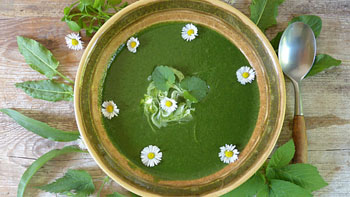
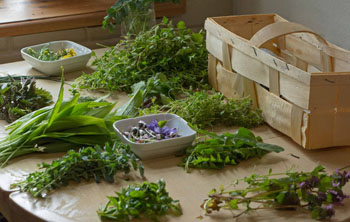 In the past, the penitents who were readmitted to the Church wore sprigs of the first greens of Spring as an expression of their joy and hope, a practice that gave the penitents the popular name of "the Green Ones" (Die Grünen). (6) Another possible explanation for the name is that in many places before the 13th century, green vestments were worn for the Holy Thursday Mass.
In the past, the penitents who were readmitted to the Church wore sprigs of the first greens of Spring as an expression of their joy and hope, a practice that gave the penitents the popular name of "the Green Ones" (Die Grünen). (6) Another possible explanation for the name is that in many places before the 13th century, green vestments were worn for the Holy Thursday Mass.
Catholic peoples from the Central European countries ate a meal consisting of all green food on this day, the greens being inspired by the Germanic name and serving as a reminder of the bitter herbs eaten at the Jewish Passover meal.
Spring being the season of budding plants, the people had no difficulty in finding flora to fill their dishes. Spinach, sorrel and other spring greens were used to make simple salads and soups. Even in America this custom was preserved amongst the Pennsylvania Dutch who continued the tradition of their German ancestors by eating spinach and dandelion greens. (7)
In many areas, only one meal, consisting of a green herb soup followed by a green salad, was eaten. The green soup, traditional in France as well as Central Europe, had to be prepared with a symbolic number of herbs (either nine or seven).
The herbs that were used varied from region to region, but the most common were the young shoots of stinging nettle, ground elder, chickweed, daisies, dandelions, plantain, sorrel, wild garlic and nettle. (8) So cherished were the traditional seven herbs of the French soup that colonists brought the custom to the New World where, in New Orleans, the vendors called out to passersby: "Buy your seven greens for good luck!" (9)
The healing and cleansing properties of the Spring greens eaten on Holy Thursday had a symbolic connection to the liturgy. Since ancient times, people have valued the first greens of the year, because they were believed to contain all the power of the flowing juices in the plants. The first greens of Spring are signs of hope, cleansing those who partake of them, just as the Holy Thursday liturgy of the past cleansed the sinners who had done penitence, thus establishing a new life of spring in their souls.
This theme of penance and purification caused this day to be chosen as a day in which to engage in cleansing of a more material kind.
Purification for Easter
Holy Thursday became known as "Clean Thursday" or "Pure Thursday" in Russia and Eastern European countries, because penitents and catechumens were permitted to bathe to be prepared for the "Mass of Remission," at which they were cleansed of their sins and received back into the Church.
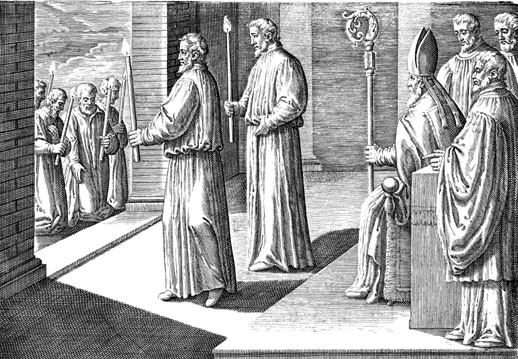 Many of the faithful imitated this custom, thoroughly washing their hair and bodies, so that, being purified in the flesh, they could be better disposed to receive the purifying graces of the
Triduum.
Many of the faithful imitated this custom, thoroughly washing their hair and bodies, so that, being purified in the flesh, they could be better disposed to receive the purifying graces of the
Triduum.
The British and Scandinavians called this day "Shere Thursday," because it was customary for monks and laymen to "shear" their hair or beard on this day in preparation for the feast of Easter. The word "shere" or "sheer" comes from the Middle English shere or sheere, meaning "pure," "unalloyed," "clear." In this way, "shere" alludes not only to the act of cutting, but also to the purification of body and soul which took place on Holy Thursday. (11)
Before sunrise in Central and Eastern European countries, mothers sent their children to the nearest river to bathe in the cold water as a cure for laziness. When the children returned from their bath, they were given the Holy Thursday sweet rolls with honey. Many Czech men washed themselves in a stream at midnight on Holy Thursday in honor of Our Lord, who fell in the Brook Kidron as He was led from Gethsemane to the house of Caiphas.
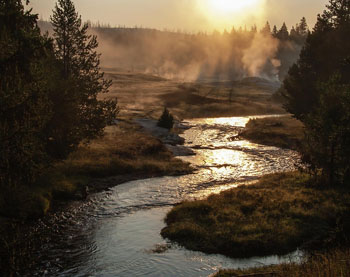 Cleanliness was not a requisite for the body alone: the whole house had to be spotless by the evening of Holy Thursday. Chimneys were swept, blankets aired, larders and kitchens well-scrubbed, and floors and walls cleaned until they shone. The first three days of Holy Week were reserved for this Spring cleaning, but Holy Thursday often found the people giving the finishing touches to their work.
Cleanliness was not a requisite for the body alone: the whole house had to be spotless by the evening of Holy Thursday. Chimneys were swept, blankets aired, larders and kitchens well-scrubbed, and floors and walls cleaned until they shone. The first three days of Holy Week were reserved for this Spring cleaning, but Holy Thursday often found the people giving the finishing touches to their work.
Czech, Slovak and Russian peasants used the blessed willow branches from Palm Sunday to beat the bedding and sweep every corner of the floor. No speck of dirt was left unnoticed; the Slovak women swept even the yards and streets. After the sweeping, a wisp of straw was used to sprinkle holy water around the house.
In Russia and other Eastern European countries, the pristine house was then beautified: mats were spread on the floor, beautiful towels displayed, and thresholds decorated with willow branches in preparation for the great feast. (12)
Such was the ardor with which our Catholic forbears prepared for the holy feast of Easter and such ought our fervor also to be. The symbols of the liturgy and of nature harmonically show us how we can sanctify our domestic tasks during these holiest of days.
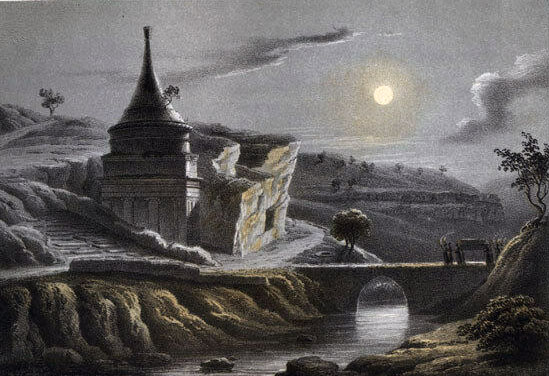 Continued
Continued

Posted April 13, 2022

Medieval illumination of the Last Supper
In the Middle Ages, there were three Masses celebrated on this day. The first Mass was the "Mass of Remission" during which the public penitents were solemnly received back into the Church. The second Mass, which is still said today, is the "Chrism Mass". During it the Bishop blesses the holy oils to be used in his Diocese in the coming year. The third Mass is the "Mass of the Lord's Supper" in commemoration of the institution of the Holy Eucharist and the priesthood.
The symbolism of the liturgy of these Masses inspired Catholic peoples to develop their own particular customs and devotions.
Bread Baking in honor of the Bread of Life
The day on which the Bread of Life fed His Apostles with His own Body and Blood could not but inspire Catholic housewives to choose this day to bake bread as a remembrance of their beloved Lord. In many countries, special rolls were eaten at the Holy Thursday breakfast. According to tradition, the rolls were always served with honey.

Above, Italian Panini di Ramerino;
below, Czech Jidášky sweet rolls with honey

Every region had their unique recipes for Holy Thursday rolls. In Florence, every good housewife baked Panini di Ramerino (rosemary buns), marking each bun with a cross. In Germany, the rolls were filled with honey and called Judasohren (Judas' ears) or Judasbrötchen, while in Czechoslovakia the Jidášky (sweet breads shaped like ropes) were made. (2)
These rolls bearing Judas' name were a reminder to children and adults alike of the tragic fate of the infamous traitor. (3)
Housewives also began preparing their Easter breads on this day so that they might receive a special blessing for having been baked on the day on which bread's true end was revealed.
Bulgarian housewives made a new leaven on Holy Thursday by mixing maize, hops, dried beans or chickpeas with the bread dough. (4) Greek housewives baked their sweet Easter bread (tsoureki) filled with spices and shaped into symbolic forms. (5) Indeed, throughout the Catholic world women, inspired by the spirit of their regions, dutifully baked their typical Easter breads, thus paying tribute to the sublime mysteries of the day.
Greens & renewal
The Bread of Life gave Himself to us amid the Spring when the dark, dead landscape of Winter is replaced with vibrant green foliage. For this reason, Green Thursday (Gründonnerstag) is the name given to Holy Thursday in Germanic and Slavic countries.
The exact origin of this name is unknown, but many believe that the name derives from the old German word "greinen" (weinen in modern German), meaning to weep. This is perhaps an allusion to the readmission of the penitents into the Church on this day.

Nine-herb soup for 'Green Thursday'; below, the traditional herbs gathered for Holy Thursday

Catholic peoples from the Central European countries ate a meal consisting of all green food on this day, the greens being inspired by the Germanic name and serving as a reminder of the bitter herbs eaten at the Jewish Passover meal.
Spring being the season of budding plants, the people had no difficulty in finding flora to fill their dishes. Spinach, sorrel and other spring greens were used to make simple salads and soups. Even in America this custom was preserved amongst the Pennsylvania Dutch who continued the tradition of their German ancestors by eating spinach and dandelion greens. (7)
In many areas, only one meal, consisting of a green herb soup followed by a green salad, was eaten. The green soup, traditional in France as well as Central Europe, had to be prepared with a symbolic number of herbs (either nine or seven).
The herbs that were used varied from region to region, but the most common were the young shoots of stinging nettle, ground elder, chickweed, daisies, dandelions, plantain, sorrel, wild garlic and nettle. (8) So cherished were the traditional seven herbs of the French soup that colonists brought the custom to the New World where, in New Orleans, the vendors called out to passersby: "Buy your seven greens for good luck!" (9)
The healing and cleansing properties of the Spring greens eaten on Holy Thursday had a symbolic connection to the liturgy. Since ancient times, people have valued the first greens of the year, because they were believed to contain all the power of the flowing juices in the plants. The first greens of Spring are signs of hope, cleansing those who partake of them, just as the Holy Thursday liturgy of the past cleansed the sinners who had done penitence, thus establishing a new life of spring in their souls.
This theme of penance and purification caused this day to be chosen as a day in which to engage in cleansing of a more material kind.
Purification for Easter
Holy Thursday became known as "Clean Thursday" or "Pure Thursday" in Russia and Eastern European countries, because penitents and catechumens were permitted to bathe to be prepared for the "Mass of Remission," at which they were cleansed of their sins and received back into the Church.

Penitents kneel at the door of the cathedral to be readmitted on Holy Thursday
The British and Scandinavians called this day "Shere Thursday," because it was customary for monks and laymen to "shear" their hair or beard on this day in preparation for the feast of Easter. The word "shere" or "sheer" comes from the Middle English shere or sheere, meaning "pure," "unalloyed," "clear." In this way, "shere" alludes not only to the act of cutting, but also to the purification of body and soul which took place on Holy Thursday. (11)
Before sunrise in Central and Eastern European countries, mothers sent their children to the nearest river to bathe in the cold water as a cure for laziness. When the children returned from their bath, they were given the Holy Thursday sweet rolls with honey. Many Czech men washed themselves in a stream at midnight on Holy Thursday in honor of Our Lord, who fell in the Brook Kidron as He was led from Gethsemane to the house of Caiphas.

Parents sent children to bathe in mountain streams to cleanse their bodies for the Triduum
Czech, Slovak and Russian peasants used the blessed willow branches from Palm Sunday to beat the bedding and sweep every corner of the floor. No speck of dirt was left unnoticed; the Slovak women swept even the yards and streets. After the sweeping, a wisp of straw was used to sprinkle holy water around the house.
In Russia and other Eastern European countries, the pristine house was then beautified: mats were spread on the floor, beautiful towels displayed, and thresholds decorated with willow branches in preparation for the great feast. (12)
Such was the ardor with which our Catholic forbears prepared for the holy feast of Easter and such ought our fervor also to be. The symbols of the liturgy and of nature harmonically show us how we can sanctify our domestic tasks during these holiest of days.

The remains of Absolom's Tomb hovers over Kidron Brook,
where Our Lord stumbled & fell
- Sophie Hodorowicz Knab, Polish Customs, Traditions, and Folklore (New York: Hippocrene Books, 1996), p. 99.
- Richard Thonger, A Calendar of German Customs (London: Oswald Wolff, 1966), p. 35.
- http://www.myczechrepublic.com/czech_culture/czech_holidays/easter/green_thursday.html
- Mercia MacDermott, Bulgarian Folk Customs (London and Philadelphia: Jessica Kingsley Publishers, 1998), p. 211.
- George A. Megas, Greek Calendar Customs (Athens: B. and M. Rhodis, 1963), p. 96.
- http://www.brauchtumsseiten.de/a-z/g/gruendonnerstag/home.html
- Katherine Burton and Helmut Ripperger, Feast Day Cookbook (Catholic Authors Press, 2005), p. 50.
- http://www.brauchtumskalender.at/brauch-109-gruendonnerstag
- Evelyn Birge Vitz, A Continual Feast (San Fransisco: Ignatius Press, 1985), p. 187.
- In "Festival" printed by Wynkyn de Worde in 1511: "Yf a man aske why Shere Thursday is called so, ye may saye that in Holy Churche it is called (Cena Domini) our Lordes Souper daye; for that day he souped with this Discyples openly; and after souper he gave them his flesshe and his blode to ete and drynke. It is also in Englysshe called Sher Thursdaye, for in olde faders dayes the people wold that daye sher there heedes, and clyppe theyr berdes, and poll theyr heedes, and so make them honest ayenst Ester Day."
- William S. Walsh, Curiosities of Popular Customs and of Rites, Ceremonies, Observances, and Miscellaneous Antiquities (Philadelphia: J. B. Lippincott Company, 1898), p. 672.
- Polina Rozhnova, A Russian Folk Calendar (Moscow: Novosti, 1992), pp. 68-69.

Posted April 13, 2022
______________________
______________________
 |
 |
 |
 |
 |
 |


